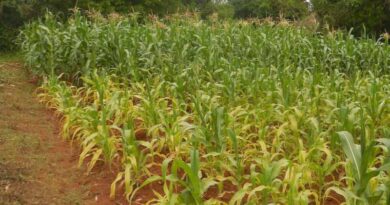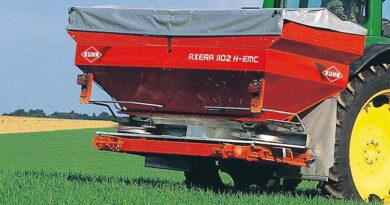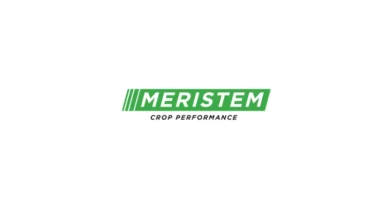Trends in fertilisation technology
30 October 2023, UK: (DLG). In recent years, innovations and trends in the area of fertilisation technology have been aimed primarily at increasing efficiency, environmental protection and resource efficiency. The present trend is also continuing at this year’s Agritechnica. The highly volatile markets for fertiliser in the recent past, particularly for mineral fertilisers, have clearly shown the necessity for the most efficient fertiliser application with the lowest possible nutrient loss. One essential element of further developments is the integration of automation technology and simplifications in the operation and control of the application systems.
Prevention of incorrect application on cornering
When applying mineral fertiliser using centrifugal spreaders, excessively and insufficiently fertilised areas within a field occur on cornering due to different speeds within the working width. At curvaceous field boundaries, it can occur that fertiliser flies beyond the boundary due to technical reasons. This has to be avoided under all circumstances from a water and resource protection perspective. At Agritechnica AMAZONE will be presenting a software option called CurveControl for the top-class ZA-TS and ZG-TS fertiliser spreaders in order to prevent incorrect application on cornering. The system measures the curve radius, calculates the radial speeds that occur and the necessary repositioning of the spreading disc. Possible incorrect application is compensated by adjusting the output point and quantity control through the control algorithm. No comparable systems are available as yet.
Easier fertiliser spreader coupling
Coupling mineral fertiliser spreaders to tractors can occasionally prove to be an unpleasant feat of strength. Rolling devices are now virtually standard for being able to park and move the implements flexibly. Rauch has developed the AutoCoupling system to make coupling even easier. In this case, the two front parking rollers are electrically driven. Batteries on the implement ensure that the electric motors are supplied with power. By means of a camera on the front of the machine, the position of the tractor and the lower links is registered using AI algorithms and the implement is automatically moved to a coupling position. The AutoCoupling function can be called up and started via the Rauch app. The mechanical, hydraulic and electrical connection elements are then coupled manually by the operator.
Pneumatic fertiliser spreaders: blockages are reported
In terms of distribution accuracy within the working width, pneumatic fertiliser spreaders are the benchmark in mineral fertiliser application. Blockages within boom feed tubes result in uneven distribution and are often very difficult for the user to detect. With BlockageDetect, Rauch has developed a solution that enables application monitoring with the aid of digital cameras on both boom elements and artificial intelligence. If one or both outlet manifolds malfunction, AI algorithms with image recognition output an alarm message via the ISOBUS control system and inform the user. Assignment and checking are made easy by the indication of the outlet number concerned. The system is fully integrated into the machine’s ISOBUS control system and is to be offered inexpensively on the market.
Increased power for organic fertilisation
The limited spreading periods for organic fertilisation necessitate high power. Accordingly, increases in working widths and volumes have been and remain a continuous element of new and further developments. Andreas Demmler has equipped its Cultan spreader with a 21 metre wide star wheel injector to enable area performance to be increased. With the Fullject X1500, Veenhuis is offering an extended form of its X-line series with a 15 metre wide slurry injector. The implement can also be used with a working width of nine metres. To be able to handle the hoses on spreaders with a working width of up to 18 metres, Agrometer A/S has equipped its SRS hose reel with a nine metre long boom arm for hose coiling. The length was previously six metres, as a result of which the maximum possible spreader width was limited to 12 metres. At Agritechnica, Bomech will be presenting its new trailing shoe distributor boom for hoses with a working width of 15 and 18 metres. With this, the company is responding to increasing demand in the area of effective hose technology. The booms are ISOBUS-controlled as standard and fold up in compact form behind the tractor for safe road transport.
Adjustment to ground structure and tramlines
Optimum ground adjustment on cropped terrain is a design challenge with increasing working widths of distribution booms in organic fertiliser application. With the TSB2 trailing shoe boom with active pressure management, Samson offers the option of actively adjusting the pressure of the trailing shoes to be able to respond to different soil types, field conditions or growth stages. The boom’s extensions can swivel horizontally up and down on either side. This enables precise adjustment to the ground contour in order to apply the fertiliser close to the ground.
Contractors that are active in the area of farm slurry spreading often have customers with different tramline spacings. Being able to react flexibly is therefore very important. Bomech has tackled the demands of such flexibility by developing a new drag hose boom with a maximum working width of 36 metres. The newly developed boom can be retracted by 7.5 metres on both sides and can steplessly cover a working range of 21 to 36 metres. If the boom is retracted, hose after hose pivots up via a curved path. As the hoses kink in the middle, they are leak tight.
Solutions with NIRS technology and ISOBUS control system
Assessment of the constituents of liquid organic fertilisers using NIRS sensors has already been familiar and available on the market for a few years. With OptiSensor Assist, Samson is heralding in the use of NIRS technology in its universal spreaders. Application can therefore be assigned to constituent target values and is no longer based on the target quantity, as was previously the case. The system can also document the nutrient quantities of nitrogen, phosphorus and potassium for a specific field.
Zunhammer will be presenting its newly developed ECO-Duo Vario system at Agritechnica. The system is based on the ISOBUS control system and regulates different slurry or nutrient quantities separately and variably per half side. Two variable pumps that operate separately from one another each supply one half side of the boom. Application maps can be processed to a previously unattained level per half side. If the distribution outlets of one half side are shut off by the automatic section control due to overlapping, the delivery quantity of the respective slurry pump is regulated accordingly to keep the quantity output per hectare constant.
When spreading solid farm manure, precision application has so far been possible by adjusting the scraper floor speed. The transport floor speed directly influences the distribution of the manure in organic fertilisation. Departure from the optimum advance speed can result in negative influences on lateral material distribution. With SpeedControl, Bergmann is presenting a solution that regulates the forwards speed of the tractor through the integration of TIM into the ISOBUS control system, as a result of which variable output quantities are possible without negative consequences for lateral distribution due to inappropriate transport floor speeds. With this software solution, the scraper floor speed remains constant to enable optimum lateral distribution.
Preventing manure from being thrown back
Automated and simple solutions are the current trend. Briri will soon be offering automated lowering of the retaining wall on universal spreaders with horizontal rollers in order to prevent manure from being thrown back towards the cab. The system regulates lowering automatically without driver intervention depending on the current weight of the load or the distance covered by the scraper floor. Manure throw-back reduction is what Briri calls its new product, which contributes to increasing user safety and comfort.
Also Read: Innovative Label Design: Revolutionizing Agrochemical Packaging in India
(For Latest Agriculture News & Updates, follow Krishak Jagat on Google News)















